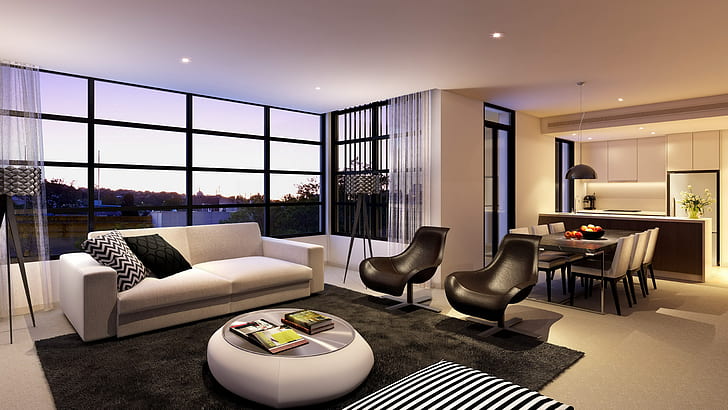In the world of creating spaces, there exists a harmonious relationship between two distinct yet intimately connected disciplines: architecture and interior design. Together, they weave a tapestry of beauty and functionality, transforming blueprints into awe-inspiring living spaces. From the grandeur of iconic architectural landmarks to the intimate coziness of a well-appointed home, the intersection of architecture and interior design captivates our senses and elevates our daily experiences.
Architecture is the art and science of designing and constructing buildings, emphasizing structural integrity, aesthetics, and the integration of form with function. It encompasses the creation of innovative structures that are not just visually striking but also serve a purpose. Meanwhile, interior design focuses on the meticulous curation of a space’s interior elements to enhance its functionality, aesthetics, and overall ambiance. It delves into the selection of materials, colors, furnishings, and decorative elements that transform mere rooms into welcoming havens and vibrant gathering places.
When architecture and interior design collaborate, magic happens. Architects provide the foundation, shaping the physical structure that will house dreams, aspirations, and everyday life. Their mastery of scale, proportion, and spatial relationships sets the stage for a dynamic interplay of light, texture, and volume. On the other hand, interior designers embark on a creative journey, adding their artistic flair and expert eye to the blank canvas provided by the architectural blueprint. They infuse personality, style, and functionality into the space, ensuring that every nook and cranny speaks to the occupants’ needs and desires.
This article dives into the profound synergy between architecture and interior design, exploring how they intertwine and influence one another to create captivating spaces. We will unveil the pivotal role played by each discipline in the realization of architectural marvels and delve into the intricate dance that takes place when designing interiors that complement and enhance the surrounding structure. Join us on this journey as we unravel the secrets behind the seamless marriage of architecture and interior design, embracing the transformative power they possess in turning a vision into a breathtaking reality.
The Relationship Between Architecture and Interior Design

Architecture and interior design are two closely intertwined disciplines that work together to shape the built environment. They share a symbiotic relationship, each playing a vital role in creating spaces that are not only aesthetically pleasing but also functional and practical.
At its core, architecture lays the foundation for a building’s structure and form. It encompasses the overall design, scale, and layout of the space, as well as the materials used and the construction techniques employed. Architects have the unique ability to shape the physical environment, taking into account factors such as site context, climate, and the needs of the occupants.
Interior design, on the other hand, focuses on the interior spaces within a building. It deals with the selection and arrangement of furniture, fixtures, and finishes, as well as the enhancement of the overall atmosphere and mood. Interior designers have a keen eye for aesthetics and are skilled in creating cohesive and functional interiors that align with the intended purpose of the space.
The relationship between architecture and interior design is inherently collaborative. Architects and interior designers work hand in hand to ensure that the overall vision for a project is realized. While architects set the stage with their building designs, it is the interior designers who bring those designs to life by carefully curating and crafting the interior spaces. This synergy between the two disciplines is crucial in creating harmonious and cohesive environments that enhance the quality of life for those who inhabit them.
In conclusion, architecture and interior design are inseparable components of the design process. They are interdependent disciplines that work together to create spaces that are not only visually appealing but also functional and livable. Their collaboration allows for a holistic approach to design, resulting in spaces that are truly remarkable in their beauty and purpose.
Creating Harmonious Spaces
When it comes to the synergy between architecture and interior design, creating harmonious spaces is of utmost importance. A successful collaboration between these two disciplines requires careful consideration of various elements such as aesthetics, functionality, and ergonomics.
One key aspect of achieving harmony in architectural and interior design is the seamless integration of the two. By aligning the architectural features with the interior design choices, a cohesive visual language can be established. This can be seen in the use of materials, colors, and textures that complement and enhance the architectural design, creating a sense of continuity and flow.
In addition to visual harmony, the practicality of a space should also be taken into account. Efficient space planning is essential in ensuring that the interior design not only looks appealing but also serves its intended purpose. This involves evaluating the needs and requirements of the users and incorporating elements that promote ease of use and functionality. By striking the right balance between aesthetics and functionality, harmonious spaces can be created.
Furthermore, the psychological impact of design choices should not be underestimated. The interplay between architecture and interior design can significantly influence the mood and atmosphere of a space. Through strategic use of lighting, furniture layout, and spatial arrangement, designers can evoke specific emotions and create spaces that are not only visually pleasing but also foster a sense of well-being.
In conclusion, the synergy between architecture and interior design is essential for the creation of harmonious spaces. By considering the integration of design elements, efficient space planning, and the psychological impact of design choices, designers can collaborate to transform a blueprint into a beautiful and functional environment.
The Impact of Interior Design on Architecture
Interior design plays a crucial role in shaping the overall impact and success of architectural designs. It goes beyond mere aesthetics, bringing functionality and harmony to the spaces we inhabit.
Firstly, interior design has the power to enhance the overall experience within a building. Through thoughtful selection of materials, colors, and textures, interior designers can create an atmosphere that evokes specific emotions and moods. Whether it’s a cozy and inviting living room or a sleek and professional office space, the interior design choices greatly influence how people perceive and interact with the architecture.
Secondly, interior design can greatly optimize the functionality of a space. Effective space planning ensures that rooms and areas are designed with their purpose and users in mind. A well-designed interior takes into account factors such as traffic flow, accessibility, and the specific needs of the occupants. By creating spaces that are both visually appealing and functional, interior design enhances the usability and practicality of the architecture.
Lastly, interior design adds layers of detail and personality to architectural designs. It brings the blueprint to life, transforming it into a vibrant and engaging environment. Through the careful selection of furnishings, lighting, and accessories, interior designers add character and uniqueness to each space, making it truly one-of-a-kind. This attention to detail helps create a cohesive and harmonious relationship between the architecture and the interior design.
In conclusion, interior design has a profound impact on architecture. It enhances the overall experience, optimizes functionality, and adds depth and personality to architectural designs. By recognizing the importance of collaboration between architects and interior designers, we can create spaces that not only please the eye but also provide a meaningful and functional experience for the users.
